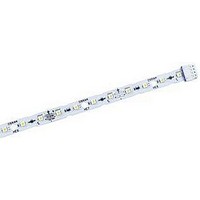LINEAR/OS/LM01A/HOW2-847 10V OSRAM SYLVANIA, LINEAR/OS/LM01A/HOW2-847 10V Datasheet - Page 4

LINEAR/OS/LM01A/HOW2-847 10V
Manufacturer Part Number
LINEAR/OS/LM01A/HOW2-847 10V
Description
LED LIGHT MODULE, WHITE
Manufacturer
OSRAM SYLVANIA
Series
LINEARlight FLEX TOPLEDr
Datasheet
1.BACKLITE610OSLM03BO.pdf
(27 pages)
Specifications of LINEAR/OS/LM01A/HOW2-847 10V
Led Module Type
Board + LED + Connector
Led Color
White
Cct
4700K
Luminous Flux @ Test
57lm
Supply Voltage
10V
Forward Current @ Test
400mA
Power Rating
4.2W
Lead Free Status / RoHS Status
Contains lead / RoHS non-compliant
M
D
L
E
S
Y
S
T
E
S
For more complete product information visit www.sylvania.com
242
HOW DOES AN LED WORK?
LED PACKAGES
ELECTRICAL DATA
TEMPERATURE RESPONSE
LIFETIME AND DEGRADATION
WHITE LIGHT LEDs
A light-emitting diode consists of several layers of semicon-
ductor material. When the diode is forward biased, light is
generated in a thin layer, the so-called active layer. Unlike
incandescent lamps, which radiate a continuous spectrum, an
LED emits an almost monochromatic light of a particular color.
The color of the light depends on the material used. Two mate-
rial systems - AlInGaP and InGaN - are used for creating high
brightness LEDs in all colors from red to blue and also in white
using phosphors.
The efficiency of LEDs has very much improved in the last few
years, and has already reached levels of 30lm/W and more -
depending on the color. This is the result of high-quality pro-
duction and advanced technologies.
The typical size of an LED is approximately a few hundred micrometers. The semiconductor is mounted in a package for easy electrical
contact and environmental protection. There are two basic types of packages:
The highest luminosity is produced with a DC voltage source. The necessary forward voltage depends on the color of the LED light, vary-
ing between 2 and 4 V at forward currents up to 70mA.
The optical output power drops as temperature increases. Temperature dependence is more significant in yellow LEDs than in green
ones. This drop in power, as a function of temperature, can be reversed and has nothing to do with degradation. The maximum operat-
ing temperature for LEDs is normally 100 °C, and this should not be exceeded.
Just like a conventional source of light, the intensity of LED light gradually diminishes in the course of continuous operation. When an
LED produces 50% of its original luminous efficiency, it has, by definition, reached the end of its life.
Under reasonable operating conditions LEDs can last up to 100,000 hours.
To generate white light, the radiation of a blue diode is used to stimulate a secondary (fluorescent) emission from a properly chosen
phosphor. By setting the appropriate concentration of luminescent material, the blue primary light from the diode combined with the yel-
low light emitted by the phosphor creates a spectral wavelength distribution that is perceived as white by the human eye. The color ren-
dering index thus achieved is approximately 80.
•THT (through-hole technology)
This kind of package is soldered "through holes" to the circuit board. The most common type is the radial 5 mm
package. The LED chip is seated in the reflector, which is connected to the cathode lead. A bond wire establish-
es electrical contact to the anode. The light is emitted by a lens integrated into the package. Different radiation
characteristics are produced as a function of chip-to-lens spacing and the shape of the lens.
•SMT (surface-mount technology)
This modern design consists of a plastic package that also serves as the reflector. The LED chip is seated in the
cavity. This cavity is filled with epoxy resin to improve light output and protect the chip against environmental
influences. SMT components can be assembled faster and with better quality than THT components.
OSRAM OPTO SEMICONDUCTORS:
LED TECHNOLOGY IS THE FUTURE
LED chip
conductive glue
active layer
bond wire
substrate

















